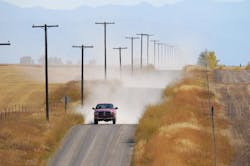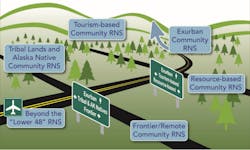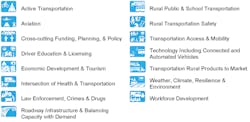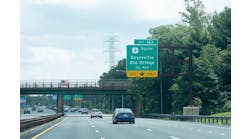By: Carla Little
When someone says rural transportation, what do you picture?
- A two-lane highway with large trucks transporting crops or the county expressway that takes urban commuters to the suburbs?
- A daily bus service in a small city of 50,000 or the once-a-week shuttle in a remote town of 500 that takes residents to the nearest hospital?
- Plows clearing snow in the north or hurricane evacuation routes in the south?
Rural transportation is all of that and more. In fact, for those who work to improve safety and mobility in rural transportation networks, it can be challenging to capture the scope and complexity of what’s needed. “Rural transportation issues are both cross-cutting and unique,” said Jaime Sullivan, Director of the National Center for Rural Road Safety. “We share some needs with urban areas like best materials for construction or best practices for maintenance and operations, but there are others that urban areas rarely deal with, like insufficient communications infrastructure for communicating with emergency responders and collecting transit data or educating drivers on how to safely share the road with wide, slow-moving agricultural equipment.”
Over the past few years, the Transportation Research Board (TRB) within the National Academy of Sciences has begun to focus more attention on how to address both longstanding and emerging rural transportation challenges in a more systematic matter. In particular, TRB and its applied research programs have sponsored several efforts that are helping improve the definition of rural and create a research agenda of the most critical transportation needs.
Defining Rural—it’s complicated
In 2018, TRB’s National Cooperative Highway Research Program (NCHRP) approved funding for a project to develop a Research Roadmap for Rural Transportation Issues (NCHRP 20-122), for which Sullivan is the Principal Investigator. The goal was to develop a detailed, long-term agenda for research aimed at improving rural transportation throughout the U.S., including the creation of a series of research needs statements on specific topics.
Before attempting to define a list of priority issues, however, the research team first tackled a clear definition for rural itself—which has eluded policymakers for decades. “Ask anyone who’s ever applied for a rural transportation grant, and they’ll tell you that the eligibility criteria for ‘rural’ varies from agency to agency, and sometimes program to program,” said David Kack, Director of the Western Transportation Institute. “While some agencies use population thresholds, others may look at population density or distance to the closest urban center.”
For its working definition of rural, the Roadmap project team focused on creating categories of rural communities, based on geographic, economic, and social characteristics. This approach resulted in a novel framework of six community types:
- Resource-oriented
- Exurban
- Tourism-based
- Frontier and remote
- Beyond the lower 48 states
- Tribal lands/native villages
“Our list of categories may not be perfect yet—as you can see, there is some overlap,” said John Shaw, an Iowa State University research scientist who collaborated with Sullivan on the Roadmap project. “However, we’re very pleased with how it illustrates the diversity of rural communities across the country and why you need to adapt rural infrastructure and programs to local needs.”
Others in transportation research are already building on this model. As part of an FHWA project “Emerging Technologies and Opportunities for Improved Mobility and Safety for Rural Areas,” researchers developed a rural classification system to guide their case study selections of technologies and opportunities by categorizing rural areas at the county level. “As we started thinking about how to address safety challenges in various locations, the influence of different rural characteristics in the various county types becomes more evident,” said Natalie Villwock-Witte, Principal Investigator for the FHWA project. “This inspired us to expand and refine rural categories.”
In an expansion of the six categories from the Roadmap project, the project team defined eight rural county categories—four based on population size, density, and economic characteristics and four more based on characteristics known to influence mobility and safety. In a subsequent Cooperative Research Program (CRP) project (BTS-15: “Highway Safety Behavioral Strategies for Rural Areas”), researchers are further refining the classification system to focus on specific rural road safety issues. “We see this as an ongoing process,” said Adam Blair, a principal at EBP US and a researcher for both the FHWA and BTS projects. “We expect to continue to update county typologies as we gather more data or as the demographics in rural counties change.”
Adding detail to the map—the list of critical research needs grows
While the work to improve the definition of rural has provided some insightful context, the core of the project has been developing and prioritizing the critical research topics. And once started, there was no shortage of input. During the first phase, the research team scoured the literature, databases, and other sources to create fact sheets centered around 14 initial themes; identified early action projects; and developed preliminary research needs statements for discussion at the first stakeholder workshop. “We had 35 participants at the first workshop, and they offered detailed feedback on our initial research plan, not to mention a wealth of information about their day-to-day transportation challenges,” said Sullivan. “We added 18 research needs statements to our project based on this workshop alone.”
In the second project phase, the team focused on fleshing out longer-term research needs, organized into a portfolio of critical needs by the themes, which now numbered 15. This process was guided by three additional workshops and a webinar, securing input from practitioners and leadership at TRB, state and federal departments of transportation, local agencies, research institutes, and more. “It was an extensive undertaking, but we really want to create a comprehensive, balanced research roadmap,” said Sullivan. “So, our outreach process had to include a diverse range of rural transportation stakeholders, community types, and topics.”
Ultimately, the research team and their many collaborators produced 15 topical research portfolios, which can be shared as background and educational documents; 26 research needs statements; and 13 research problem statements, which are more fully developed project proposals ready to submit for funding consideration. To illustrate the breadth of topics covered, here’s a small sampling of priority research issues selected for inclusion in the Roadmap:
- Clarifying Relationships Between Rural Economic Development and Transportation Investments
- Data Requirements Supporting Safety Improvements on Unpaved Roads
- Guidebook for Improving Connectivity to Intercity Bus Services
- Policy Coordination to Improve Rural Non-Emergency Medical Transportation (NEMT)
- Sustainability and Mode Choice in the Essential Air Service (EAS) Program
- Realistic Solutions for Funding Rural and Small-town Pedestrian Infrastructure
Perhaps the most important success? Three of the problem statements have already been selected for funding. “NCHRP will sponsor projects related to recreation travel needs in rural areas and the development of a national intercity bus atlas, while TCRP [TRB’s transit research program] will provide funding for a project to create a design guide for rural transit systems,” said Sullivan. “It’s encouraging to see the implementation of the Roadmap get underway.”
Finding a “home” for rural research
To keep the momentum of the Roadmap going, team members and collaborators will need to build awareness, pursue funding opportunities, assess progress, and refine the plan. But how do you do that within the confines of a time-limited research project? “We have always envisioned the Roadmap as a useful, “living document” that can be updated as research is completed and needs evolve,” said Charles Carr, NCHRP 20-122 Panel Chair and Director of Intermodal Transportation at Mississippi DOT. “But we quickly realized that the Roadmap would need a home where rural champions could keep these issues alive.”
Enter the new TRB Rural Transportation Issues Coordination Council, established in the spring of 2020. Coordination Councils play a unique role within the TRB research structure. Only five councils are allowed to be active at any one time, and TRB reserves them for “cross-cutting issues, often complex multimodal and multidisciplinary” (CC Planning Document, TRB 2020). The Rural Council will provide guidance, coordinate strategies, and convene forums of experts on critical rural issues and has agreed to take on the Roadmap as one of its initiatives.
With key issues defined and documented, research projects moving forward, and a supportive TRB council in place, rural transportation research is well-positioned to help advance further progress on how to safely and efficiently move both people and goods around the country. “Over the last few years, rural interests within research, transportation, nonprofit organizations, and other communities have come together like never before to tell the rural story in an articulate and compelling way,” said Sullivan. “It’s the foundation for significant and long-term improvements to the transportation systems that serve 60 million people and more than 95% of our nation’s land.”
To follow the implementation progress of the Research Roadmap project and other activities of the TRB Rural Transportation Issues Coordination Council, you can become a Friend of the Council (#A0040C) by registering at MyTRB, or contact Council Chair Jaime Sullivan at [email protected] for more information.
About The Author: Little is Communications Specialist for the Western Transportation Institute.






